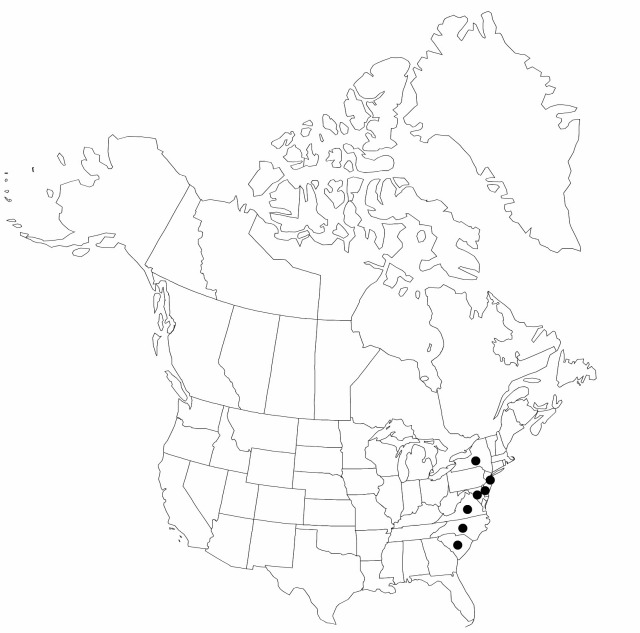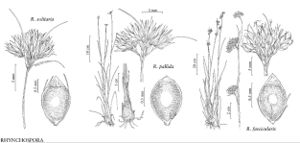Difference between revisions of "Rhynchospora pallida"
Amer. J. Sci. Arts, ser. 2: 7: 409. 1849.
FNA>Volume Importer |
imported>Volume Importer |
||
| (6 intermediate revisions by 2 users not shown) | |||
| Line 7: | Line 7: | ||
|year=1849 | |year=1849 | ||
}} | }} | ||
| − | |basionyms={{Treatment/ID/ | + | |special_status={{Treatment/ID/Special_status |
| + | |code=F | ||
| + | |label=Illustrated | ||
| + | }}{{Treatment/ID/Special_status | ||
| + | |code=E | ||
| + | |label=Endemic | ||
| + | }} | ||
| + | |basionyms={{Treatment/ID/Basionym | ||
|name=Rhynchospora curtisii | |name=Rhynchospora curtisii | ||
|authority=Steudel | |authority=Steudel | ||
| + | |rank=species | ||
| + | |publication_title= | ||
| + | |publication_place=1855 | ||
}} | }} | ||
|synonyms={{Treatment/ID/Synonym | |synonyms={{Treatment/ID/Synonym | ||
|name=Phaeocephalum pallidum | |name=Phaeocephalum pallidum | ||
|authority=(M. A. Curtis) House | |authority=(M. A. Curtis) House | ||
| + | |rank=species | ||
}} | }} | ||
|hierarchy=Cyperaceae;Rhynchospora;Rhynchospora pallida | |hierarchy=Cyperaceae;Rhynchospora;Rhynchospora pallida | ||
| Line 37: | Line 48: | ||
-->{{#Taxon: | -->{{#Taxon: | ||
name=Rhynchospora pallida | name=Rhynchospora pallida | ||
| − | |||
|authority=M. A. Curtis | |authority=M. A. Curtis | ||
|rank=species | |rank=species | ||
| Line 51: | Line 61: | ||
|publication title=Amer. J. Sci. Arts, ser. | |publication title=Amer. J. Sci. Arts, ser. | ||
|publication year=1849 | |publication year=1849 | ||
| − | |special status= | + | |special status=Illustrated;Endemic |
| − | |source xml=https:// | + | |source xml=https://bitbucket.org/aafc-mbb/fna-data-curation/src/2e0870ddd59836b60bcf96646a41e87ea5a5943a/coarse_grained_fna_xml/V23/V23_426.xml |
|genus=Rhynchospora | |genus=Rhynchospora | ||
|species=Rhynchospora pallida | |species=Rhynchospora pallida | ||
Latest revision as of 20:40, 5 November 2020
Plants perennial, cespitose, 40–100 cm, base bulbous; rhizomes stoloniferous, short, wiry. Culms erect or excurved, linear, leafy, trigonous, slender. Leaves slightly to much exceeded by culm; blades ascending, narrowly linear, proximally flat, 1–3 mm wide, apex trigonous, tapering gradually, setaceous. Inflorescences terminal; spikelet single, terminal cluster of spikelets crowded, hemispheric, 2.5 cm wide; leafy bracts linearsetaceous, much exceeding cluster. Spikelets whitish to tan, narrowly lanceoloid, (3.5–)4–5.5 mm, apex acuminate; fertile scales lanceolate, 3.5–4(–4.5) mm, apex narrowly acute, minutely awned or apiculate. Flowers: bristles vestigial or obsolete. Fruits 1 per spikelet, (1.9–)2–2.3 mm; body brown with pale center, lenticular, broadly ellipsoid, 1.5–2 × 1.5 mm, margins flowing to tubercle; surfaces longitudinally finely striate; tubercle depressedtriangular, 0.2–0.3(–0.4) mm.
Phenology: Fruiting late spring–fall.
Habitat: Sands and peats of clearings in pine flatwoods, barrens, and savannas
Elevation: 0–200 m
Distribution

Del., Md., N.J., N.Y., N.C., S.C., Va.
Discussion
Selected References
None.
